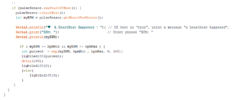imane tech
New Member
Hello Community! I'm facing some problems to understand the code that I want to work with on my project. I found it hard to understand some comments on the code, that I found on Github. In brief, I'm looking forward to doing a simulation of a signal related to my heartbeat sensor. You'll find down below the schematic of the circuit, the code, and the picture of the comment that I didn't understand. Thanks for your help!!
regards, Imane.
regards, Imane.





